CAD likely caused blood clot during brain surgery: Case report
Clot formed despite measures to prevent hypothermia

Cold agglutinin disease (CAD) was the likely cause of blood clot formation during brain surgery in a 57-year-old man, despite measures to prevent his body temperature from getting too low, a case study in Turkey showed.
Because the clot occurred at the site where two brain blood vessels were being connected, surgeons considered it could be related to the use of room-temperature saline to irrigate the surgical field.
“Preventing hypothermia [abnormally low body temperature] is extremely important in the anesthesia management of CAD patients,” the researchers wrote. “However, careful attention must also be paid to temperature regulation in the surgical field.”
The case report, “Intraoperative vascular anastomosis occlusion due to cold agglutinin disease during brain surgery: a case report,” was published in JA Clinical Reports.
CAD is a rare autoimmune disease caused by a specific type of self-reactive antibodies, called cold agglutinins, which bind to red blood cells at cold temperatures, causing them to clump together and leading to their destruction. This in turn leads to the formation of blood clots that can block vessels and cause acrocyanosis, or bluish discoloration of the skin, especially the hands and feet. Red blood cell destruction leads to anemia, or low counts of red blood cells to transport oxygen to the body tissues, that can lead to fatigue and other CAD symptoms.
Temperature control during surgery
Because CAD symptoms worsen at low temperatures, patients are at a higher risk of complications during surgeries, when anesthetics and skin exposure can cause the body temperature to drop. Strict control of temperature during surgery is crucial to reduce these potentially triggering effects.
The researchers described the case of a 57-year-old man with CAD who developed a thrombotic occlusion — when a blood clot is formed inside blood vessels and obstructs blood circulation — during brain surgery.
He was diagnosed with CAD three months before the surgery, following the onset of limb acrocyanosis and blood in the urine after being exposed to cold temperatures during snow removal.
Two months after diagnosis, the man exhibited weakened muscle movements in the left side of the body and speech difficulties. He was diagnosed with stroke caused by the formation of a blood clot in an artery that supplies the brain, with the consequent shortage of blood and oxygen supply to a part of the brain.
He was scheduled for cerebral artery bypass surgery to create a new route to go around the vessel blockage and restore blood supply. This involves vascular anastomosis, or procedures to connect two blood vessels.
Laboratory work before the surgery confirmed the presence of several CAD-specific features, including high levels of cold agglutinins and the presence of C3d, a type of immune protein, bound to red blood cells. He also had elevated D-dimer, a marker of blood -clotting conditions.
The man was taking medication to prevent blood clots, but stopped two days before surgery. He was under general anesthesia during surgery, and several measures were taken to maintain his body core temperature.
The room temperature was kept elevated, the man was covered with a warming system, and into-the-vein fluids were warmed. His extremities were monitored for acrocyanosis.
Despite his body temperature being consistently maintained between 36.5 C (97.7 F) and 37.3 C (99.14 F), the surgeon detected the formation of a blood clot where two blood vessels had first been connected.
The blood vessel was quickly opened, the clot was removed, and heparin, an anti-clotting medication, was administered directly into the bloodstream, and the saline fluid used to irrigate the surgical field was replaced with warmed saline at 38 C (100.4 F) to prevent further blood clotting.
“In this case, irrigation with room-temperature saline may have induced … [blood vessel obstruction] due to thrombus [blood clot] formation,” the researchers wrote. “This emphasizes the necessity of maintaining both [whole-body] and local irrigation fluids at normothermic levels (37–38 C) [98.6-100.4 F].”
After re-establishment of the affected new blood vessel connection and its blood flow, the surgery was completed without further events. The patient recovered without neurologic deficits or signs of CAD such as anemia or acrocyanosis. The man was transferred to a rehabilitation unit eight days after the surgery.
“It can be speculated that CAD was the main cause of thrombus formation in this case,” the team wrote. “Brain surface temperature monitoring, occasionally used in cases of severe head trauma, may prove beneficial in regulating the temperature of the surgical field to prevent cold agglutination, as observed in this case.”







